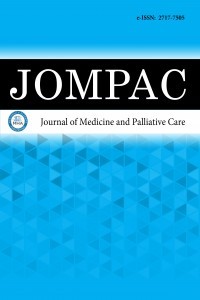Hashimoto tiroiditinde IL-35 düzeyleri ve tiroid fonksiyon testleri ile ilişkisi
Hashimoto tiroiditi, antiinflamatuar sitokin, otoimmünite, IL-35
IL-35 levels and their association with thyroid function tests in Hashimoto’s thyroiditis
Hashimoto’s thyroiditis, antiinflammatory cytokine, autoimmunity, IL-35,
___
- Volpe R. The Life of Dr. Hakaru Hashimoto. Autoimmunity 1989; 3: 243-5.
- Larsen PR, Davies TF. Hypothyroidism and thyroiditis. In: Larsen PR, Kronenberg HM, Melmed S, Polonsky KS (eds). Williams Textbook of Endocrinology (10th ed). Philadelphia: WB Saunders, 2002; p:432-449.
- Baker JR Jr. Autoimmune endocrine disease. JAMA 1997; 278: 1931-7.
- Birinci N. Hashimoto tiroiditli çocuk hastaların demografik, klinik ve prognostik özellikleri. Ondokuz Mayıs Üniversitesi Tıp Fakültesi, Çocuk Sağlığı ve Hastalıkları Uzmanlık Tezi, Samsun, 2009.
- Koloğlu endokrinoloji temel ve klinik II. Baskı 2005 Prof. Dr. Gürbüz Erdoğan editörlüğünde Prof. Dr. Nilgün Baykal sayfa: 271.
- Volpe R. Autoimmune thyroiditis. In: Braverman LE, Utiger RD.Werner and ingbar’s the Thyroiditis. 6th ed. Philadelphia: Lippincott; 1991; 921-923.
- Dayan CM, Daniels GH. Chronic autoimmune thyroiditis. New Engl J Med 1996; 335: 99–107.
- Cappa M, Bizzarri C, Crea F. Autoimmune thyroid diseases in children. J Thyroid Res 2010; 2011: 675-703.
- Pathogenesis of Hashimoto’s Thyroiditis,Uptodate 2013 [cited 2013 23.05.2013]; Available from: http://www.uptodate.com/contents/pathogenesis of Hashimoto’s thyroiditis
- Tandon N, Metcalfe RA, Barnett D, Wheetman AP. Expression of the costimulatory molecule B7/BB1 in autoimmune thyroid disease. QJ Med 1994; 87: 231-6.
- Greiner DL, Handler ES, Nakano K, Mordes JP, Rossini AA. Absence of the RT-6 T cells in diabetes-prone BB/W rats. J Immunol 1986; 136: 148–51.
- Martin A, Davies TF. T cells and human autoimmune thyroid disease: emerging data show lack of need to invoke suppressor T cell problems. Thyroid1992; 2: 247–61.
- Dayan CM, Daniels G. Chronic autoimmune thyroiditis 2006; 335: 2.
- Karakurt F. Hashimoto tiroiditi hastalarında adiponektin düzeyleri üzerine parp-1 gen polimorfizmlerinin etkisinin araştırılması. İstanbul Üniversitesi sağlık Bilimleri Enstitüsü, Tıbbi Biyoloji Yüksek Lisans Tezi, İstanbul, 2012.
- Collison LW, Vignali DA Interleukin-35: odd one out or part of the family? Immunol Rev 226: 248–62.
- Chaturvedi V, Collison LW, Guy CS, Workman CJ, Vignali DA. Cutting edge: human regulatory T cells require IL-35 to mediate suppression and infectious tolerance. J Immunol 2011; 186: 6661–6
- Mai J, Wang H, Yang XF. Th 17 cells interplay with Foxp3+ Tregs in regulation of inflammation and autoimmunity. Front Biosci 2010; 15: 986–1006.
- Collison LW, Workman CJ, Kuo TT, et al. The inhibitory cytokine IL-35 contributes to regulatory T-cell function. Nature 2007; 450: 566–9.
- Başlangıç: 2020
- Yayıncı: MediHealth Academy Yayıncılık
Melih HANGÜL, Mehmet KÖSE, Hüseyin PÜR, Murat DOĞAN, Emrah TÜRK, Ali ERSOY, Mehmet Adnan ÖZTÜRK
Yaşlı hastalarda SGLT2 inhibitörü kullanımı: laboratuvar değerlendirilmesi
Enes Seyda ŞAHİNER, Oğuzhan ZENGİN
Murat ÖNAL, Mehmet AĞAR, Tuğba GÜRBÜZ
Yoğun bakım yatışı sırasında radyoterapi endikasyonu konulan hastalarda tedavi sonuçlarımız
Gonca ALTINIŞIK İNAN, İpek Pınar ARAL, Tarık KARGIOĞLU, Çağkan ERGİDEN, Yılmaz TEZCAN
Primer hipolipoproteinemili hastalarda monosit/yüksek yoğunluklu lipoprotein kolesterol oranı
Ezgi EREM, Fatih Mehmet KIŞLAL
Gülçin TÜRKMEN SARIYILDIZ, Mehmet Emin DEMİR, Zafer ERCAN, Ulaş SÖZENER, Canan ÇİÇEK, Aykut İlker ARSLAN, Fatma Necla ÖZŞEKER
Fatih VAROL, Yasar Yusuf CAN, Büşra ÖZGÜNAY, Mehmet CENGİZ, Ugur ALTAS, Şirin GÜVEN, Halit CAM
Delta nötrofil indeksinin aksiller metastazları belirlemede tanısal değeri
